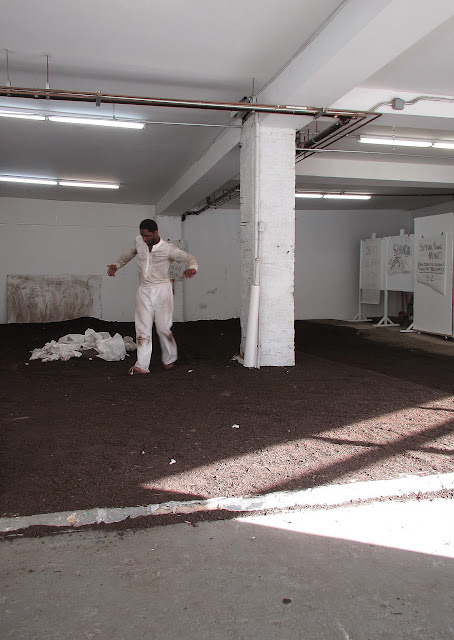 |
| John Scott's La MaMa production of HYPERACTIVE, starring (clockwise from front, left) Stuart Singer, Ryan O'Neill, Marcus Bellamy and Kevin Coquelard (photo: Jinyoul Lim) |
Give up the struggle.
In the arm wrestling between physical movement and verbal expression, the body wins. See? Even there: It's arm wrestling.
I give in.
As a writer, I will never keep up with what John Scott's dancers do in HYPERACTIVE (2013), a presentation by Irish Modern Dance Theatre, currently at the La MaMa Moves! Dance Festival. This Irish import, billed as a "human dance installation," takes pretty much everything the bodies of Kevin Coquelard, Ryan O'Neill, Marcus Bellamy and Stuart Singer have to offer. Thank goodness what these men have to offer is a lot. My wife was surprised when I returned home so quickly from Scott's show, which is only fifty-minutes long. I told her, "Had it gone any longer, they would have killed themselves."
You get a sense of HYPERACTIVE, right from the start, as Coquelard, first on the scene, violently scrunches his nose and mouth in ways that will be familiar to anyone suffering New York's spring allergy attacks. Coquelard probably doesn't have a seasonal allergy, but what he has, in HYPERACTIVE, is the essence of something only likely to grow in irrational force.
He's soon joined by Bellamy, whose truncated tale of a dog who likes to chase lizards and another dog with floppy ears quickly gives way to full-bodied howling and floppiness. When the two guys face each other, wind up and wind up and wind up, spin and stumble and wind up some more and guffaw and scamper, it's clear that HYPERACTIVE is going to be a little nuts. And the body will win.
Scott's sense of funny scrambles over any flimsy barrier. What is an "invisible hand dance?" Don't ask. What does an all-male chorus line and a Mack truck have in common? Why does Marcus's "inner geometry" look more like how Jackson Pollock might drip a dance? What might it be like to stop to smell the roses only to have a herd of bison gallop by only inches away? What's the DMZ between exhilarating exuberance and bodily danger? Sit along either of two available sides of the actual dance space, as I did, and you will find out. Or you could sit in La MaMa's regular theater seats and stay all cool and stuff.
HYPERACTIVE wears its own "inner geometry" on the outside. Random steps are often identified by name--as are people, by first names, some of whom I recognized for their connections to Scott and his work. Phrases are vocally counted. Exertion is demonstrated in the booming slap of feet against floor and the rivulets of sweat against skin and soaking clothing. The work embraces transparency and anti-virtuosity in its raucousness, its grin at failure, its refusal to go anywhere near pretty payoff or uplift.
And four butts are worked off, relentlessly, for the entire fifty minutes.
With music by JG Everest and Blackfish; Michael Galasso
Co-presented by the Irish Arts Center, HYPERACTIVE continues at La MaMa tonight at 7:30 and tomorrow at 2pm. For information and tickets, click here.
The First Floor Theatre @ La MaMa
74A East 4th Street (between Bowery and Second Avenue), Manhattan
(map/directions)




























.jpg)












